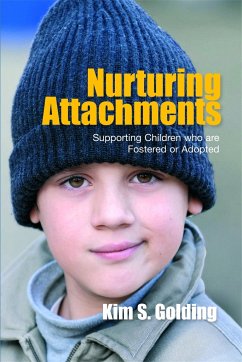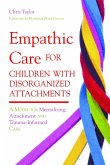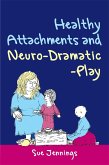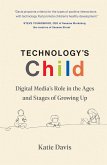- Broschiertes Buch
- Merkliste
- Auf die Merkliste
- Bewerten Bewerten
- Teilen
- Produkt teilen
- Produkterinnerung
- Produkterinnerung
Nurturing Attachments combines the experience and wisdom of parents and carers with that of professionals to provide support and practical guidance for foster and adoptive parents looking after children with insecure attachment relationships. It gives an overview of attachment theory and a step-by-step model of parenting.
Andere Kunden interessierten sich auch für
![Creating Loving Attachments Creating Loving Attachments]() Daniel HughesCreating Loving Attachments29,99 €
Daniel HughesCreating Loving Attachments29,99 €![Empathic Care for Children with Disorganized Attachments Empathic Care for Children with Disorganized Attachments]() Chris TaylorEmpathic Care for Children with Disorganized Attachments35,99 €
Chris TaylorEmpathic Care for Children with Disorganized Attachments35,99 €![Healthy Attachments and Neuro-Dramatic-Play Healthy Attachments and Neuro-Dramatic-Play]() Dr Sue JenningsHealthy Attachments and Neuro-Dramatic-Play45,99 €
Dr Sue JenningsHealthy Attachments and Neuro-Dramatic-Play45,99 €![Nurtureshock Nurtureshock]() Ashley MerrymanNurtureshock23,99 €
Ashley MerrymanNurtureshock23,99 €![Technology's Child Technology's Child]() Katie DavisTechnology's Child15,99 €
Katie DavisTechnology's Child15,99 €![Nurturing Natures Nurturing Natures]() Graham Music (Tavistock and Portman Clinics, London, UK)Nurturing Natures52,99 €
Graham Music (Tavistock and Portman Clinics, London, UK)Nurturing Natures52,99 €![Nurturing Equality, Diversity and Inclusion Nurturing Equality, Diversity and Inclusion]() Aleksandra Thomson (University of Bristol)Nurturing Equality, Diversity and Inclusion18,99 €
Aleksandra Thomson (University of Bristol)Nurturing Equality, Diversity and Inclusion18,99 €-
-
-
Nurturing Attachments combines the experience and wisdom of parents and carers with that of professionals to provide support and practical guidance for foster and adoptive parents looking after children with insecure attachment relationships. It gives an overview of attachment theory and a step-by-step model of parenting.
Produktdetails
- Produktdetails
- Verlag: Jessica Kingsley Publishers
- Seitenzahl: 240
- Erscheinungstermin: 15. Dezember 2007
- Englisch
- Abmessung: 235mm x 161mm x 13mm
- Gewicht: 366g
- ISBN-13: 9781843106142
- ISBN-10: 1843106140
- Artikelnr.: 23245594
- Herstellerkennzeichnung
- Libri GmbH
- Europaallee 1
- 36244 Bad Hersfeld
- gpsr@libri.de
- Verlag: Jessica Kingsley Publishers
- Seitenzahl: 240
- Erscheinungstermin: 15. Dezember 2007
- Englisch
- Abmessung: 235mm x 161mm x 13mm
- Gewicht: 366g
- ISBN-13: 9781843106142
- ISBN-10: 1843106140
- Artikelnr.: 23245594
- Herstellerkennzeichnung
- Libri GmbH
- Europaallee 1
- 36244 Bad Hersfeld
- gpsr@libri.de
Kim S. Golding, MSc Clinical Psychology, DClinPsy, previously worked as a clinical psychologist at The Park Hospital for Children, Oxford, UK, and was an Associate Lecturer at the Open University, UK. She is currently a clinical psychologist with the Integrated Service for Looked After and Adopted Children (ISL) in Worcester, UK.
Section 1: Attachment Theory. 1. Overview of Attachment Theory. 2.
Attachment Theory: Caregiving and Its Impact on Attachment and Exploration.
3. Attachment Theory: Patterns of Attachment. 4. Difficulties in
Development: The Impact of Loss and Trauma. 5. Parenting Children with
Attachment Difficulties. Experiencing Relationships as Secure. 6. Parenting
and Patterns of Attachment. Section 2: A Model for Parenting the Child with
Difficulties in Attachment Relationships: Providing a Secure Base. 7.
Introduction to the Model and Creating a Secure Base. 8. Empathy and
Support from the Secure Base. 9. Attunement and Empathy. 10. Protecting the
Family Atmosphere and the Development of Emotional Regulation. 11. Creating
a Feeling of Belonging for the Child. 12. Looking after Yourself. Section
3: A Model for Parenting the Child with Difficulties in Attachment
Relationships: Building Relationships and Managing Behaviour. 13. Helping
the child to enjoy being part of the family. 14. Learning to Parent with
PACE and Building Relationships with Stories. 15. Providing Structure and
Supervision. 16. Managing Confrontation and Coercive Interactions. 17.
Thinking, Feeling and Behavioural Choices. 18. Managing Special
Difficulties: Lying, Stealing and Self Harm. 19. Conclusion. References.
Glossary. Reading list. Subject index. Author index.
Attachment Theory: Caregiving and Its Impact on Attachment and Exploration.
3. Attachment Theory: Patterns of Attachment. 4. Difficulties in
Development: The Impact of Loss and Trauma. 5. Parenting Children with
Attachment Difficulties. Experiencing Relationships as Secure. 6. Parenting
and Patterns of Attachment. Section 2: A Model for Parenting the Child with
Difficulties in Attachment Relationships: Providing a Secure Base. 7.
Introduction to the Model and Creating a Secure Base. 8. Empathy and
Support from the Secure Base. 9. Attunement and Empathy. 10. Protecting the
Family Atmosphere and the Development of Emotional Regulation. 11. Creating
a Feeling of Belonging for the Child. 12. Looking after Yourself. Section
3: A Model for Parenting the Child with Difficulties in Attachment
Relationships: Building Relationships and Managing Behaviour. 13. Helping
the child to enjoy being part of the family. 14. Learning to Parent with
PACE and Building Relationships with Stories. 15. Providing Structure and
Supervision. 16. Managing Confrontation and Coercive Interactions. 17.
Thinking, Feeling and Behavioural Choices. 18. Managing Special
Difficulties: Lying, Stealing and Self Harm. 19. Conclusion. References.
Glossary. Reading list. Subject index. Author index.
Section 1: Attachment Theory. 1. Overview of Attachment Theory. 2.
Attachment Theory: Caregiving and Its Impact on Attachment and Exploration.
3. Attachment Theory: Patterns of Attachment. 4. Difficulties in
Development: The Impact of Loss and Trauma. 5. Parenting Children with
Attachment Difficulties. Experiencing Relationships as Secure. 6. Parenting
and Patterns of Attachment. Section 2: A Model for Parenting the Child with
Difficulties in Attachment Relationships: Providing a Secure Base. 7.
Introduction to the Model and Creating a Secure Base. 8. Empathy and
Support from the Secure Base. 9. Attunement and Empathy. 10. Protecting the
Family Atmosphere and the Development of Emotional Regulation. 11. Creating
a Feeling of Belonging for the Child. 12. Looking after Yourself. Section
3: A Model for Parenting the Child with Difficulties in Attachment
Relationships: Building Relationships and Managing Behaviour. 13. Helping
the child to enjoy being part of the family. 14. Learning to Parent with
PACE and Building Relationships with Stories. 15. Providing Structure and
Supervision. 16. Managing Confrontation and Coercive Interactions. 17.
Thinking, Feeling and Behavioural Choices. 18. Managing Special
Difficulties: Lying, Stealing and Self Harm. 19. Conclusion. References.
Glossary. Reading list. Subject index. Author index.
Attachment Theory: Caregiving and Its Impact on Attachment and Exploration.
3. Attachment Theory: Patterns of Attachment. 4. Difficulties in
Development: The Impact of Loss and Trauma. 5. Parenting Children with
Attachment Difficulties. Experiencing Relationships as Secure. 6. Parenting
and Patterns of Attachment. Section 2: A Model for Parenting the Child with
Difficulties in Attachment Relationships: Providing a Secure Base. 7.
Introduction to the Model and Creating a Secure Base. 8. Empathy and
Support from the Secure Base. 9. Attunement and Empathy. 10. Protecting the
Family Atmosphere and the Development of Emotional Regulation. 11. Creating
a Feeling of Belonging for the Child. 12. Looking after Yourself. Section
3: A Model for Parenting the Child with Difficulties in Attachment
Relationships: Building Relationships and Managing Behaviour. 13. Helping
the child to enjoy being part of the family. 14. Learning to Parent with
PACE and Building Relationships with Stories. 15. Providing Structure and
Supervision. 16. Managing Confrontation and Coercive Interactions. 17.
Thinking, Feeling and Behavioural Choices. 18. Managing Special
Difficulties: Lying, Stealing and Self Harm. 19. Conclusion. References.
Glossary. Reading list. Subject index. Author index.








